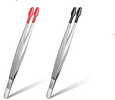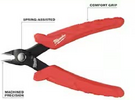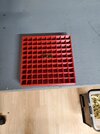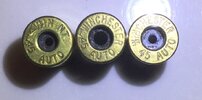You are using an out of date browser. It may not display this or other websites correctly.
You should upgrade or use an alternative browser.
You should upgrade or use an alternative browser.
PWC
Member
How do you ensure the brass will fall into place on its base?
If it falls mouth first, it will straddle the primer "button" In the loading block. But, then you would see which type primer it takes. Also, that brass would be hard to get out without long tip tweezers or or something stuck into the flash hole.
If it falls mouth first, it will straddle the primer "button" In the loading block. But, then you would see which type primer it takes. Also, that brass would be hard to get out without long tip tweezers or or something stuck into the flash hole.
Hi,How do you ensure the brass will fall into place on its base?
If it falls mouth first, it will straddle the primer "button" In the loading block. But, then you would see which type primer it takes. Also, that brass would be hard to get out without long tip tweezers or or something stuck into the flash hole.
I just put the sorter into a tight fighting box and dump the brass in and shake it. Almost all of them fall base first into the sorter. A few fall base up, so all you do is pull them out. For the tweezers, like I said in my OP, they open wide enough to grip the inside of the case and pull it out. I can make a video if this isn't clear enough.
Regards,
Ed
Jim Watson
Member
Some of the gadgeteers with two tumblers, a roll sizer, two presses, and a hundo would probably pay $500 for one made out of titanium.
GW Staar
Member
- Joined
- Feb 26, 2009
- Messages
- 3,737
I've done considerable testing with similar materials experimenting with egg crate fluorescent lighting lenses....which are almost exactly the same size.........was trying to drop 45 cases base down into feeder tubes even before Lee started their shaker idea. The cases are heavier at the base so the natural tendency is to drop base down. The only time I had trouble with that is when I tried to load too much at a time where they layered and the top layers forced some to drop upside down. I had no problem as long as I sprinkled only a single layer at a time. I don't think people will have any trouble at all unless you dump a whole nut jar full at the same time.
I went looking for forceps that I might just buy ($7 ain't bad)....these look to be perfect corner to corner, made for stamp collectors:
Just bought them.....

I went looking for forceps that I might just buy ($7 ain't bad)....these look to be perfect corner to corner, made for stamp collectors:
Just bought them.....

Last edited:
PWC
Member
Reason I asked is I tried something like this with the plastic trays that come with .45 and 30-06 comm'l ammo by hand pouring over the trays and 20 to 30% went in upside down.Hi,
I just put the sorter into a tight fighting box and dump the brass in and shake it. Almost all of them fall base first into the sorter. A few fall base up, so all you do is pull them out. For the tweezers, like I said in my OP, they open wide enough to grip the inside of the case and pull it out. I can make a video if this isn't clear enough.
Regards,
Ed
GW Staar
Member
- Joined
- Feb 26, 2009
- Messages
- 3,737
I did a little testing tonight and found out some interesting things.
First, my EggCrate lens has holes 12.5mmX12.5mm and I wanted to just test some things, so I scrounged around and found a box which fit an 8" square of the egg crate, doubled in height.....still a little shorter than a .45 but it was ok for this test.....I'm just dropping them through....... I tested .45, .40 and 9mm. And I made sure I didn't drop anything in upside down in the initial pour. This is the result:
.45 had a hard time not sticking on the diagonal ...... lots of shaking was necessary to make them drop.....zero went in usd (upside down), but I also tested pouring in several layers too, and in that case I did have a number go in usd.
.40 went in without the sticking problem....but still took a lot of shaking. Zero usd. Again I sprinkled cases and shook til full.
9mm went in like water took 3 seconds. Zero usd.
So this appears to be the conclusion......the 9mm measured aprox. 9.5 mm diameter (sized brass).....so that's 3mm smaller than the square measurement. So square hole diameter matters a lot for best efficiency.
I don't have a clue what I.S. diameter Ed's holes are, but if they are at least 3mm wider than the .45 case diameter I would expect them to perform similar to the 9mm in my test.
One thing is cool about 3D printers.....change in hole diameter. drawing cross hairs corner to corner and moving each primer cylinder is not terribly hard. In his programmer cad in fact it would require some changed numbers. He can probably do that in an hour. But then maybe his hole size is already close. My holes barely allowed .45 to go in....loose enough to slide in without friction, but not much play.
First, my EggCrate lens has holes 12.5mmX12.5mm and I wanted to just test some things, so I scrounged around and found a box which fit an 8" square of the egg crate, doubled in height.....still a little shorter than a .45 but it was ok for this test.....I'm just dropping them through....... I tested .45, .40 and 9mm. And I made sure I didn't drop anything in upside down in the initial pour. This is the result:
.45 had a hard time not sticking on the diagonal ...... lots of shaking was necessary to make them drop.....zero went in usd (upside down), but I also tested pouring in several layers too, and in that case I did have a number go in usd.
.40 went in without the sticking problem....but still took a lot of shaking. Zero usd. Again I sprinkled cases and shook til full.
9mm went in like water took 3 seconds. Zero usd.
So this appears to be the conclusion......the 9mm measured aprox. 9.5 mm diameter (sized brass).....so that's 3mm smaller than the square measurement. So square hole diameter matters a lot for best efficiency.
I don't have a clue what I.S. diameter Ed's holes are, but if they are at least 3mm wider than the .45 case diameter I would expect them to perform similar to the 9mm in my test.
One thing is cool about 3D printers.....change in hole diameter. drawing cross hairs corner to corner and moving each primer cylinder is not terribly hard. In his programmer cad in fact it would require some changed numbers. He can probably do that in an hour. But then maybe his hole size is already close. My holes barely allowed .45 to go in....loose enough to slide in without friction, but not much play.
Last edited:
Hi,You need to get a patent on that tray or other will copy it and sell it , and will make a mint.
Thanks, but like I said before, I'm not interested in making money from this, just sharing what I think is an easy, common sense solution to a problem we in the shooting community have. Besides, here's one result of a quick search on the cost of a patent:
"How Much Does it Cost?
A patent can cost from $900 for a do-it-yourself application to between $5,000 and $10,000+ with the help of patent lawyers. A patent protects an invention and the cost of the process to get the patent will depend on the type of patent (provisional, non-provisional, or utility) and the complexity of the invention."
I don't think I really want to spend that kind of $ to get a patent.
Regards,
Ed
Mostly Lead
Member
- Joined
- Oct 31, 2011
- Messages
- 205
Hi,
Thanks, but like I said before, I'm not interested in making money from this, just sharing what I think is an easy, common sense solution to a problem we in the shooting community have. Besides, here's one result of a quick search on the cost of a patent:
"How Much Does it Cost?
A patent can cost from $900 for a do-it-yourself application to between $5,000 and $10,000+ with the help of patent lawyers. A patent protects an invention and the cost of the process to get the patent will depend on the type of patent (provisional, non-provisional, or utility) and the complexity of the invention."
I don't think I really want to spend that kind of $ to get a patent.
Regards,
Ed
For some real fun, try this in Google: "cost to enforce a patent"...
(spoiler alert - it's millions!)
.45Coltguy
Member
You guys that can come up with these things with those 3D printers, is I think is so neat. Using the noodle indeed! Me? I just eyeball 'em still. I know, dinosaur.
JohnMc
Member
Don't forget the maintenance fees. Since you're a "micro entity" (I think), that'd be $400 at 3.5 years, $752 at 7.5 years, and $1,540 at 11.5 years.Hi,
Thanks, but like I said before, I'm not interested in making money from this, just sharing what I think is an easy, common sense solution to a problem we in the shooting community have. Besides, here's one result of a quick search on the cost of a patent:
"How Much Does it Cost?
A patent can cost from $900 for a do-it-yourself application to between $5,000 and $10,000+ with the help of patent lawyers. A patent protects an invention and the cost of the process to get the patent will depend on the type of patent (provisional, non-provisional, or utility) and the complexity of the invention."
I don't think I really want to spend that kind of $ to get a patent.
Regards,
Ed

Jim Watson
Member
Mine came in. I cut and taped a shaker box and decapped some of both.
I need to work on box fill and shake action but it gave a clean separation.
Unfortunately, I dumped the smalls into the large bucket, so I get to do it again.
I need to work on box fill and shake action but it gave a clean separation.
Unfortunately, I dumped the smalls into the large bucket, so I get to do it again.
PWC
Member
GW Staar
Member
- Joined
- Feb 26, 2009
- Messages
- 3,737
You can buy it at home depot in the flourescent lighting area in a 2'X4' rectangle. It's a lighting lens cover used in suspended ceilings. Not sure why they call it eggcrate. Before I got a 3d printer I did projects with it. I made a case trays and a rifle case conversion of Lee's shaker collator that worked great.....but 3D printer made things lots simpler.


Above a simple tray ..... 2 layers glued together, then glued to a 1/4" melamine base. Did another with a wood frame. Below is egg crate I was about to cut out for the (1st) rifle shaker conversion.
Below that...a video showing how it worked. Yes! I went to a lot of trouble before nirvana arrived! (The 3D printer)


Thanks to Ed, I 3D print now......SOOOOO much easier to just design and print what you need. How'd I cut the above eggcrate? flush cutting diagonal cutter (dikes) one square at a time....


Above a simple tray ..... 2 layers glued together, then glued to a 1/4" melamine base. Did another with a wood frame. Below is egg crate I was about to cut out for the (1st) rifle shaker conversion.
Below that...a video showing how it worked. Yes! I went to a lot of trouble before nirvana arrived! (The 3D printer)


Thanks to Ed, I 3D print now......SOOOOO much easier to just design and print what you need. How'd I cut the above eggcrate? flush cutting diagonal cutter (dikes) one square at a time....
Last edited:
PWC
Member
I've loaded both LPP and SPP; depends on my primer inventory. I used a single stage press, so really sorting wasn't really a problem straight from the tumbler setting up the loading blocks. No autofeed. Good thread tho; GWStaar...good video,xplains a lot.
FROGO207
Member
Great idea OP! Thank you for offering to share your hard work with others here. I presently do not 3D print but have observed that a lot of the members here do. I am sure this will be helpful to many members.
StrykerByte.45
Member
- Joined
- Feb 8, 2022
- Messages
- 289
I never thought it difficult to sort one from the other. I sort my cases by brand and normally they sort themselves. I have yet to find one brand with both sizes. I have reloaded using both, it is no big deal either.
Cool that you design your own tool though. Put it on Cults3D. Your upload date is proof of origin and you can charge a specific price for people to download the file.
Cool that you design your own tool though. Put it on Cults3D. Your upload date is proof of origin and you can charge a specific price for people to download the file.
Hi,I never thought it difficult to sort one from the other. I sort my cases by brand and normally they sort themselves. I have yet to find one brand with both sizes. I have reloaded using both, it is no big deal either.
Cool that you design your own tool though. Put it on Cults3D. Your upload date is proof of origin and you can charge a specific price for people to download the file.
Thanks for the suggestion. I've never used Cults3D before, so I'll have to check it out. Like I said in previous posts, I'm more interested in sharing with the community than making money from this. I can't claim the idea as new or innovative (maybe as a 3D printed model,) but there are other folks who have developed a very similar tool independently. One example is member @Toprudder, posted about his device on 12/21/21. Here's his post. He made his the old fashioned way with wood and screws, but the idea is the same. Basically, a go/no go gauge for LPP .45 ACP brass. I don't know when he actually made his, just posted about it in December of '21 (I looked at my original files, and I developed mine in October, 2020.) We came up with our tools completely independent of each other. Another member, @jmorris, also has some really cool go/no go tools that are automated and work on his reloading equipment. So again, thanks for your post and the suggestion.
Ed
jmorris
Member
- Joined
- Sep 30, 2005
- Messages
- 24,326
Larry in wyoming
Member
- Joined
- Dec 10, 2021
- Messages
- 632
I've been reloading for decades and until recently I naively thought all this stuff was standardized.
jmorris
Member
- Joined
- Sep 30, 2005
- Messages
- 24,326
I've been reloading for decades and until recently I naively thought all this stuff was standardized.
It was. I never picked up a SPP 45 ACP brass case before 2001 or 2002. The only SPP 45 acp I know of before that was non reloadable aluminum cases, made it a non issue for them.
Jim Watson
Member
While it may seem that the 45 Small is meant to inconvenience handloaders so they will buy more factory loads, I understand it to be a chemistry matter.
The main current lead free priming compound, Dinol, is "hotter" than lead styphnate. So the first WW unleaded I saw had a large primer and a large flash hole to vent the primer pocket pressure into the case quicker. But Dinol is also more expensive than lead styphnate and they found that they could use its intensity to get by with less of it in a small primer. It looks like they are now just loading styphnate in both as brass and primer inventory suits.
The main current lead free priming compound, Dinol, is "hotter" than lead styphnate. So the first WW unleaded I saw had a large primer and a large flash hole to vent the primer pocket pressure into the case quicker. But Dinol is also more expensive than lead styphnate and they found that they could use its intensity to get by with less of it in a small primer. It looks like they are now just loading styphnate in both as brass and primer inventory suits.
I have .45ACP cases using both SPP and LPP from Blazer, Federal, and WinchesterI have yet to find one brand with both sizes.
Similar threads
- Replies
- 17
- Views
- 713
- Replies
- 11
- Views
- 1K
- Replies
- 2
- Views
- 361
- Replies
- 59
- Views
- 14K
- Replies
- 10
- Views
- 367



